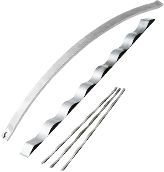- keyword
- SUS304
- flatsprings
- springmaterials
- Young'smodulus
- tensilestrength
- hardness
- SUP9
- longitudinalelasticmodulus
- SUP7
Question Spring Newbie 2017/5/23(Tue) 15:24
We are considering materials for flat springs and I would like to know the “hardness”, “tensile strength” and “Young’s modulus” (longitudinal elastic modulus)” of SUP7 and SUP9. Also, how much do they cost compared to SUS304?
Answer Tokai Spring 2017/5/23(Tue) 15:49
The mechanical properties of SUP7 and SUP9 are the same as SUP10.
Hardness: HB388-461, tensile strength min1330N / mm2, Young’s modulus 206000N / mm2.
Since the cost depends on the shape, it is difficult to make a general comparison, but if you consider only the material, I think that SUS304 will be about 1.5 times that of SUP material.
* SUS304(EQ to S30400 by ASTM, X5CrNi1810 by DIN, L-No6X5CrNi 18-9 by ISO )
Answer Spring Newbie 2017/5/25(Thu) 13:28
Thank you for your reply. This is very useful for me.
Regarding the usage environment of the flat springs that are currently under consideration, corrosion resistance, acid resistance, and high-temperature resistance (about 100°C) are required. At the moment, we are using SUS304, but it this material okay to use in this environment? Also, if you have any recommendations for SUP materials that are suitable for the above usage environment, please let us know. Thank you!
Answer Tokai Spring 2017/5/25(Thu) 15:36
SUS304 is superior to SUP material in corrosion resistance, acid resistance, and high-temperature resistance (about 100°C). SUP material is suitable only for high-temperature resistance (about 100 ℃), but it can not be used as a substitute for SUS304 because it has poor corrosion resistance and acid resistance.
* SUS304(EQ to S30400 by ASTM, X5CrNi1810 by DIN, L-No6X5CrNi 18-9 by ISO )
Answer Spring Newbie 2017/6/27(Tue) 12:12
After examining metals that are good for acid resistance and high-temperature resistance, I thought that tungsten and molybdenum would be better. Do you have any track records of making flat springs from tungsten or molybdenum?
Answer Tokai Spring 2017/6/27(Tue) 19:19
In general, there are few examples of applications of steel springs as a single component. Tungsten and molybdenum have excellent oxidation resistance and heat resistance, and are contained in spring materials .
They become chemical components and are used for alloy steels in which multiple of these components are mixed to produce springs.
For example, the above components are in spring steels such as SKD and special steel such as Inconel, which have heat resistance. I presume that the environment you mentioned is a slightly corrosive and has a temperature of around 100°C, but because there will be no particular problems such as corrosion or fatigue happen to the flat spring you are using, SUS304 is the suitable material.
If you have any problems when using it, please feel free to contact us! We will make an appropriate design proposal for you.
Answer Spring Newbie 2018/9/3(Mon) 8:57
I would like to know the characteristics and changes in shape and size when CFRP materials are used to manufacture flat springs. I also want to know the differences when the size of the flat spring and the bending angle are changed.
Answer Tokai Spring 2018/9/3(Mon) 11:18
Thank you for posting, Spring Newbie! Although the shape and size of the spring affect its characteristics, the calculation of the characteristics based on the shape and size is determined by the load method and point of use. At that time, the elastic modulus differs depending on the materials, so the characteristics can be derived by applying the elastic modulus of CFRP. However, in the case of flat springs, using a simple calculation is difficult when the shape is complicated, and the characteristics may be calculated by FEM analysis.
Answer Spring Newbie 2019/4/10(Wed) 10:34
I made a clip that looks like a tie pin by brazing 2 pieces of metal (made by brass), but the returning force was too weak. What is the best material for brazing? The size and usage of this clip are about the same as of a tie pin.
Answer Tokai Spring 2019/4/11(Thu) 18:14
Spring Newbie, thank you for posting!!!
We have track records of processing spiral-shaped springs, but we have no track record of brazing nor producing brass springs. Brass is soft and therefore it is difficult to obtain sufficient material strength as a spring. It is possible that the clip did not have a sufficient repulsive force. I don’t know the required repulsive force and usage environment, but if it is not an iron-based material, why not try using SUS CSP material if it is a thin flat spring?
If you contact us here and provide us with more details, we will propose a design for you!
We are happy to answer any inquiries regarding technology, specifications, materials, etc. Please feel free to ask.

















